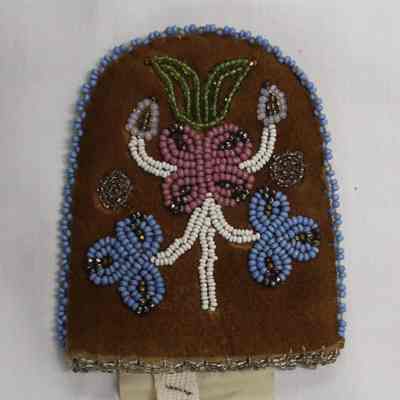Compass Case
Name/Title
Compass CaseEntry/Object ID
1989.10.3Description
Leather compass case with beadwork. The light brown suede leather is camel color while the fabric lining is cream color with pink stripes (much like pillow ticking). The beaded pattern is different on the front and back. The beadwork motif on one side depicts a green flower cradling a silver ball or bud. Below the flower are two white branches surmounted by silver buds. The branches extend from a white stem that emerges from a light purple, figure-eight form. Below the purple form are four clear and silver leaves or pods. The other side has a similar green flower, but without the silver ball. The flower sits atop a pink quatrefoil design. Two white branches emerge from either side of the quatrefoil and are surmounted by light purple and silver buds. A white stem descends from the base of the quatrefoil along with two white stems that curve outward. These stems are surmounted by light blue trefoil designs. Two clear circles flank the central motif. Open edges are lined with clear beads. Closed seam is lined with light blue beads.Context
According to Isaac Merrick's daughter, Esther Merrick Wilbur, this compass case was made for him in 1836 by Abenaki Indians living in the area of what is now Waterville, Vermont. Isaac Huse Merrick (1796-1864) was born in Bedford, New Hampshire to parents who had recently settled after leaving Newbury, Massachusetts. His family was part of the second wave of settlers who moved first from the eastern shores of Massachusetts to New Hampshire and then on to northern Vermont. Isaac Merrick is first recorded as living in Coit's Gore, the precursor to Waterville, Vermont (est. 1824) in the 1820 census. Family history, as published in a small volume by his granddaughter Mary Wilbur Westcot, place him in the area as early as 1807. There are many fanciful tales of Isaac that seem to blend fact with a healthy dose of fiction. Like any frontier settler of this time, his life would certainly have been daring and adventurous. Isaac purchased 300 acres on a hillside above the Kelley River (now known as the north branch of the Lamoille). Family records state that his farm overlooked an "Indian settlement" of "wigwams" in the river valley. Isaac farmed the land and made a name for himself as a trader/smuggler. During this time, Britain enacted fairly stiff tariffs on goods crossing the Canadian border and many enterprising Vermonters took the risk of smuggling through the mountains for potential fortune. The family stories mention Isaac's partnership with Indians in these cross-border trading endeavors. This small beaded case bears witness to this partnership with a beautiful Abenaki work of art designed to hold a European navigation device. The provenance of this item helps document an Abenaki community in the Waterville area in the first half of the 19th century as well as providing an example of stylistically distinct beadwork motifs.Acquisition
Accession
1989.10Source or Donor
Bradley, RosaleaAcquisition Method
GiftMade/Created
Date made
circa 1836Place
Town
WatervilleCounty
Lamoille CountyState/Province
VermontCountry
United States of AmericaContinent
North AmericaEthnography
Culture/Tribe
Abenaki
Native American

